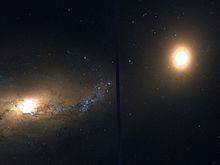Right ascension 10 23 27.0 Redshift 1151 ± 10 km/s Apparent size (V) 3′.2 × 2′.8 | Declination +19° 53′ 55″ Type E2 pec Magnitude 12.3 Apparent magnitude (V) 12.3 | |
 | ||
Similar NGC 3227, NGC 3377, NGC 3384, NGC 3607, NGC 3169 | ||
NGC 3226 is a dwarf elliptical galaxy that is interacting with the spiral galaxy NGC 3227. The two galaxies are one of several examples of a spiral with a dwarf elliptical companion that are listed in the Atlas of Peculiar Galaxies. Both galaxies may be found in the constellation Leo.
Contents
Nucleus
NGC 3226 contains a low-ionization nuclear emission-line region (LINER), a type of region that is characterized by spectral line emission from weakly ionized atoms. In general, the energy source for LINER emission has been a subject of debate among astronomers. Some astronomers have asserted that LINERs are powered by star formation regions, while other have asserted that LINERs are powered by active galactic nuclei (AGN) which contain supermassive black holes.
AGN
The nucleus of NGC 3226 appears to contain an AGN. The nucleus is a strong source of both radio and X-ray emission that appears to be synchrotron emission, which is generated when electrons moving at high speeds oscillate within magnetic fields. Such synchrotron emission is expected from the environment around a supermassive black hole. The X-ray emission may also be variable, which is also expected in the environment of a supermassive black hole.
Interstellar medium
It is possible that NGC 3226 may be acquiring gas from NGC 3227 during the interaction process, which would enhance star formation within NGC 3226. However, millimeter observations of NGC 3226 failed to detect any molecular gas within the galaxy. These results not only demonstrate that NGC 3226 contains little molecular gas but also demonstrate that the galaxy has acquired no gas from NGC 3227.
